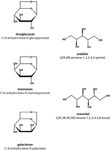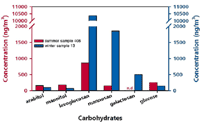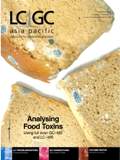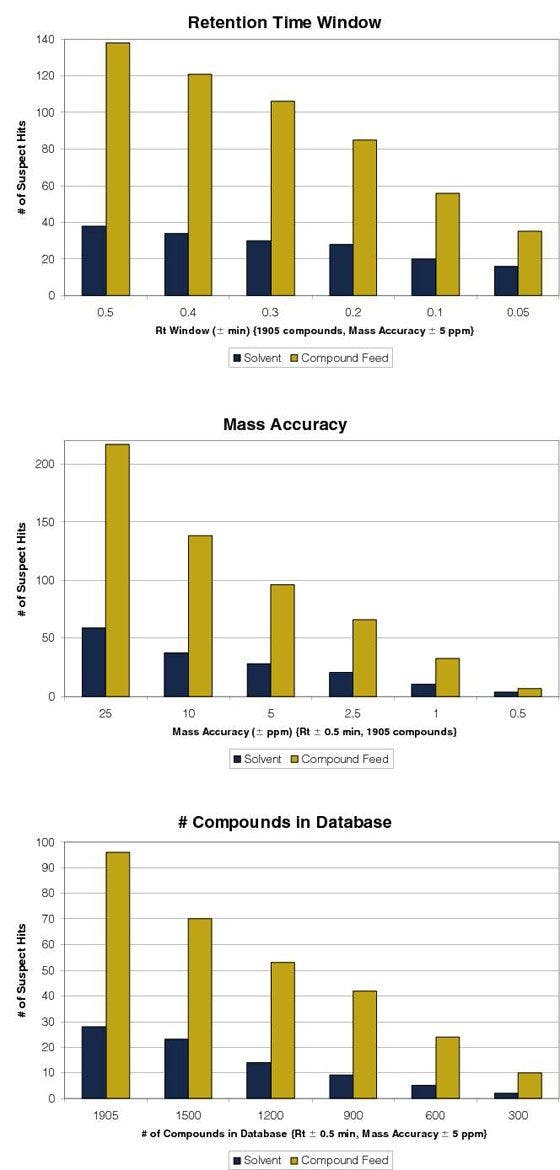Determining Saccharidic Tracers in Atmospheric Aerosols
LCGC Asia Pacific
Metrohm Application Note
Introduction
Besides vehicle emissions and industrial sources, biomass burning is one of the largest sources of air pollution. Approximately 3 billion metric tons of biomass are annually burned. Main contributions derive from residential wood burning, the burning of leaves, grass and trash as well as from wildfires. The evolving atmospheric aerosol particles — suspensions of fine solid particles or liquid droplets in a gas — can persist for days to weeks in the troposphere and thus significantly contribute to long-range particle transport. Most of the released smoke aerosol particles are smaller than 10 microns in size (PM10) and can easily enter the human lung and cause adverse health effects. Moreover, smoke aerosol particles affect cloud formation and precipitation and thus the climate in general. For this reason, properties and chemical composition of aerosol particulate matter have to be investigated.
Aerosols consist of a complex mixture of inorganic and organic compounds. Especially, the water-soluble organic compounds (WSOC) make up a major fraction of the atmospheric aerosol. Within the WSOC, the monosaccharide anhydrides levoglucosan (1,6-anhydro-beta-D-glucopyranose) and, to a lesser extent, its stereoisomers mannosan (1,6-anhydro-beta-D-mannopyranose) and galactosan (1,6-anhydro-beta-D-galactose) can be determined as thermal degradation products of structural polysaccharides present in biomass. While levoglucosan arises from the pyrolysis of cellulose, the main building material of wood, its stereoisomers mannosan and galactosan stem from the pyrolysis of hemicellulose. During the combustion of fossil fuels no anhydrosugars are released. Levoglucosan fulfils all important requirements of an ideal molecular marker necessary for source apportionment: it is abundant in wood smoke, highly source specific and relatively stable in the atmosphere. In contrast, monosaccharides are released by microrganisms, plants and animals; sugar alcohols are characteristic for fungi, lichens and bacteria. In particular, arabitol and mannitol, which are storage substances in fungal spores, can be used as valuable tracers for quantifying airborne fungal spores.1
Anhydrosugars are typically extracted into an organic solvent, derivatized with a silylation reagent and most commonly determined via gas chromatographic (GC) separation with mass spectrometric detection (MS). Due to their polar nature, these compounds are challenging to analyse by GC–MS. A faster and simpler method, which does not require relatively sophisticated and expensive analytical instrumentation, organic solvents, sample workup and derivatization, is ion chromatography (IC) followed by pulsed amperometric detection (PAD). PAD, the oxidation of electrochemical active molecule groups at a gold electrode, works well for carbohydrates and combines the advantages of an excellent sensitivity and good selectivity over other classes of compounds. Moreover, IC-PAD allows a straightforward water extraction of the large WSOC fraction of aerosols and thus excels by the possibility to handle wet samples, such as rain, fog or cloud water.2,3 Characterization of these samples is important for understanding the role of aerosols in cloud formation and precipitation.
This study presents a straightforward ion chromatographic method with amperometric detection for the simultaneous determination of the biomass burning tracer levoglucosan, its stereoisomeric anhydrosugars mannosan and galactosan as well as the sugar alcohols arabitol and mannitol (Figure 1).

Figure 1: Chemical structures of the anhydrosugars levoglucosan, mannosan and galactosan as well as of the sugar alcohols arabitol and mannitol.
Materials and methods
Instrumentation
- 871 Advanced Bioscan
- 838 Advanced IC Sample Processor
- 818 Advanced IC Pump
Reagents and eluents
Levoglucosan, the sugar alcohols and glucose were reagent grade and purchased from Fluka (Sigma Aldrich, Buchs, Switzerland). Mannosan and galactosan were obtained from Carbosynth Ltd (Berkshire, UK). All standard solutions and eluents were prepared with deionized water having a specific resistance higher than 18 M Ω.cm. A carbohydrate standard mix covering the concentration range 80...800 µg/L served to determine the system characteristics. An air monitoring agency provided the aerosol winter and summer filter sub-samples for method development.

Figure 2: PAD chromatograms of an 8-component carbohydrate standard using a Metrosep A Supp 15 â 150/4.0 column in series with a Metrosep Carb 1 â 150/4.0 (a) and a Metrosep Carb 1 â 250/4.6 (b). The following determinations were performed with the shorter Metrosep Carb 1 â 150/4.0 column; Table 1 summarizes the chromatographic parameters and the PAD settings of the method.
Separation, calibration and precision
A problem frequently encountered in the analysis of atmospherically relevant saccharidic compounds in aerosols is the poor chromatographic separation of the two compound pairs arabitol/levoglucosan and mannitol/mannosan.4 Because both pairs represent different compound classes and are important tracers for different aerosol sources, chromatographic separation is crucial. To overcome this drawback, the optimized IC-PAD method uses two columns in series, a Metrosep Carb 1 – 150/4.0 and a Metrosep A Supp 15 – 150/4.0, and thus achieves an excellent separation of anhydrosugars and sugar alcohols in a single isocratic run in less than 17 minutes [Figure 2(a)]. Separation, especially between levoglucosan and mannosan, can be further improved by using a weaker eluent or a longer carbohydrate separation column [250 mm instead of 150 mm, Figure 2(b)].

Table 1: Chromatographic parameters and PAD settings of carbohydrate determinations.
The saccharidic tracers are determined by applying a triple-step potential waveform: a positive potential E1 to determine the carbohydrates followed by a stronger pulse E2 for oxidative desorption of adsorbed species and finally a third, negative potential E3 to reactivate the electrode's surface (Table 1). The entire sequence lasts one second and is continuously repeated. PAD detection is highly sensitive and as shown in Figure 3, calibration curves are linear over a wide concentration range. Calibration curves for the atmospherically important saccharidic compounds have correlation coefficients (R) better than 0.9998 (Table 2). The reproducibility of the IC-PAD method was evaluated for the peak height of each carbohydrate with RSDs equal to or less than 2%. The detection limit for levoglucosan was estimated to be below 10 µg/m3 using a 100 µL loop. With an extraction volume of 4 mL, 5 ng/m3 levoglucosan aerosol concentration can be determined. These data show the suitability of IC-PAD to accurately quantify water-extractable saccharidic compounds in atmospheric aerosols.

Figure 3: Calibration curves of (a) the sugar alcohols inositol, erythritol, arabitol and mannitol as well as of (b) the anhydrosugars levoglucosan, mannosan and galactosan using linear regression.
Filter extraction
Contribution of biomass smoke and biogenic sources to ambient aerosol levels is determined by collecting the aerosol fraction of a defined air volume on a filter. Before extraction, the 15 cm diameter glass fibre filter, through which 80 m3 air was drawn, was subdivided into 4.7 cm diameter filter samples. After addition of 14 mL ultrapure water, the filters were treated by ultrasonic extraction for about 30 minutes. Before injection, samples were filtrated through a 0.45 µm syringe filter. Alternatively, Metrohm's Inline Ultrafiltration was used. In case concentrations on the filters are very low, the extraction volume may be reduced to 4 mL.

Table 2: Linearity and precision of the developed method.
Results
Seasonal variations in summer and winter samples
Table 3 shows the results of the determined carbohydrate concentrations of three analysed winter and four summer filter extracts. Figure 4 contains the chromatograms of an exemplary winter (ID 13) and summer sample (ID 408); corresponding aerosol concentrations in ng/m3 are plotted in the bar chart of Figure 5. The anhydrosugars levoglucosan and mannosan as well as the sugar alcohols arabitol and mannitol and the monosaccharide glucose were detected in each filter. Galactosan was only quantified in one summer filter in the low µg/L range. In both summer and winter samples, levoglucosan was the most dominant identified carbohydrate. The highest levoglucosan concentration, approximately ten times higher than that detected in summer, was observed in winter, when residential wood burning for heating purposes was most intense.

Table 3: Overview of analysed glass fibre winter and summer samples and corresponding carbohydrate concentrations.
In summer, concentrations of combustion-derived anhydrosugars strongly decreased whereas the contributions of biogenic sugars and sugar alcohols increased. Arabitol and mannitol summer aerosol concentrations even achieved mannosan levels. These results are consistent with the fact that in summer the biological activity and thus the emission of biogenic volatile organic compounds such as fungal spores and plant pollen is at their maximum.

Figure 4: PAD chromatogram obtained from the analysis of (a) the winter sample 13 and (b) the summer sample 408.
Conclusions
Ion chromatographic determination coupled with pulsed amperometric detection is highly sensitive and selective to saccharidic aerosol tracers. After straightforward water extraction of the filters, atmospheric tracers for biomass combustion and for biogenic sources can be determined at the ng/m3 scale. The method requires no complex sample pretreatment or derivatization and is well suited to handle a large number of samples. The IC-PAD method is an invaluable tool for the distinction between anthropogenic and natural aerosol emissions and offers novel insights for elucidating the impact of atmospheric aerosols on the climate.

Figure 5: Bar chart comparing the detected carbohydrate concentrations in (a) the winter sample 13 and (b) the summer sample 408.
References
1. H. Bauer et al., Atmospheric Environment, 42, 588–593 (2008).
2. G. Schkolnik and Y. Rudich, Anal. Bioanal. Chem., 385, 26–33 (2006).
3. G. Schkolnik et al., Environ. Sci. Technol., 39, 2744–2752 (2005).
4. A. Caseiro et al., J. Chromatogr. A, 1171, 37–45 (2007).
Metrohm International Headquarters

Oberdorfstrasse 68, CH-9101 Herisau, Switzerland
tel. +41 71 353 85 04
E-mail: aw@metrohm.com
Website: www.metrohm.com

Determining Enhanced Sensitivity to Odors due to Anxiety-Associated Chemosignals with GC
May 8th 2025Based on their hypothesis that smelling anxiety chemosignals can, like visual anxiety induction, lead to an increase in odor sensitivity, a joint study between the University of Erlangen-Nuremberg (Erlangen, Germany) and the Fraunhofer Institute for Process Engineering and Packaging (Freising, Germany) combined behavioral experiments, odor profile analysis by a trained panel, and instrumental analysis of odorants (gas chromatography-olfactometry) and volatiles (gas chromatography-mass spectrometry).
Investigating 3D-Printable Stationary Phases in Liquid Chromatography
May 7th 20253D printing technology has potential in chromatography, but a major challenge is developing materials with both high porosity and robust mechanical properties. Recently, scientists compared the separation performances of eight different 3D printable stationary phases.
Detecting Hyper-Fast Chromatographic Peaks Using Ion Mobility Spectrometry
May 6th 2025Ion mobility spectrometers can detect trace compounds quickly, though they can face various issues with detecting certain peaks. University of Hannover scientists created a new system for resolving hyper-fast gas chromatography (GC) peaks.

.png&w=3840&q=75)

.png&w=3840&q=75)



.png&w=3840&q=75)



.png&w=3840&q=75)














